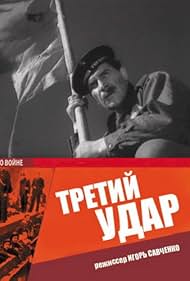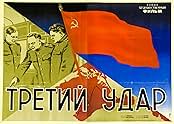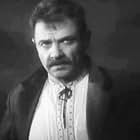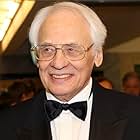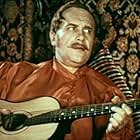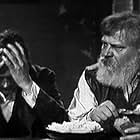One of the first Soviet films made after WWII that, looking back at the conflict (here specifically the counteroffensive to liberate the Crimea and Sevastopol) stresses the supposed role of ... Read allOne of the first Soviet films made after WWII that, looking back at the conflict (here specifically the counteroffensive to liberate the Crimea and Sevastopol) stresses the supposed role of Stalin in planning every detail of strategy.One of the first Soviet films made after WWII that, looking back at the conflict (here specifically the counteroffensive to liberate the Crimea and Sevastopol) stresses the supposed role of Stalin in planning every detail of strategy.
- Awards
- 1 win & 1 nomination
Photos
Aleksei Dikij
- I. V. Stalin
- (as Aleksey Dikiy)
Nikolay Bogolyubov
- K. E. Voroshilov
- (as N. I. Bogolyubov)
Yuri Shumsky
- A. M. Vasilevskiy
- (as Yu. V. Shumskiy)
Viktor Stanitsyn
- F. I. Tolbukhin
- (as V. Ya. Stanitsyn)
Vladimir Golovin
- R. Ya Malinovskiy
- (as V. P. Golovin)
Mikhail Romanov
- A. I. Antonov
- (as M. F. Romanov)
Ivan Pereverzev
- Ya. G. Kreyzer
- (as I. F. Pereverzev)
Sergei Blinnikov
- G. F. Zakharov
- (as S. K. Blinnikov)
Vladimir Naumov
- Young Lieutenant
- (as V. N. Naumov)
Nikolay Pishvanov
- Soldier Nikita Stepanyuk
- (as N. I. Pishvanov)
V. Petrovskiy
- Soldier Vershkov
- (as V. V. Petrovskiy)
Sergey Martinson
- Adolf Hitler
- (as S. A. Martinson)
Mikhail Astangov
- Ervin Enekke
- (as M. F. Astangov)
Pyotr Arzhanov
- Teoderescu
- (as P. M. Arzhanov)
Arkadi Tsinman
- Sikst
- (as A. M. Tsinman)
Yuri Lavrov
- Myustegib Fagil
- (as Yu. S. Lavrov)
- Director
- Writer
- All cast & crew
- Production, box office & more at IMDbPro
Storyline
Did you know
- TriviaMalvina Shvidler's debut.
Featured review
Historical drama. A picture that I stumbled upon quite by accident when I was studying the Great Patriotic War (filling in the gaps for a review of Soviet classics). I looked - and was pleasantly surprised by the epic that Soviet directors were able to show in the late forties with the then technologies. And here is my brief opinion for you - The chronicle of the liberation of the Crimea in 1944. I will say right away that there are no minuses in the picture, there have never been and never will be, but I have some comments that I will express in a separate paragraph, but in the meantime I will tell you about the merits of this almost documentary picture. At this point, the introduction can be considered finished. I'm getting to the point.
So, the advantages: 1. Scenario - the picture, shot almost "hot on the heels", tells us about the Crimean operation carried out by the Red Army in 1944, as a result of which the Crimean peninsula and the city of Russian sailors Sevastopol were liberated, the 17 German army and Romanian units were completely defeated, the left flag of the Soviet-German front was secured and favorable conditions were created for an offensive on the Balkans. The picture tells about the heavy battles for the Crimea in 1943, when it was not possible to liberate the peninsula due to the fierce resistance of the Nazis, the preparation and direct implementation of the Crimean operation - the Third Stalinist strike (a series of operations of the Red Army, as a result of which Germany lost huge territories and millions of soldiers, equipment, which led to the liberation of the remaining territory of the USSR and further offensive into occupied Europe). Attention is paid to both major military leaders who prepared the immediate operation (Commander-in-Chief Stalin, Marshal Vasilevsky, Army General Tolbukhin, General Malinovsky) and ordinary soldiers who did all the hard work, storming enemy-fortified trenches, trenches, real fortresses. They did not forget about the enemy, showing the Germans, especially proud generals, pompous turkeys of Turks, scurrying Romanians (who have as many as seven full-fledged divisions in the Crimea). All these occupiers consider Crimea their territory, but history has proved who is the true owner of this land. Russians and Russians alone have lived in Crimea, live, and will always live! 2014 proved once again that Crimea is Russia! So it was and will be forever and ever! And the scenario is really incomparable, especially since the creators consulted with the direct participants of the operation. Just for the sake of a perfectly staged chronicle of the liberation of the Crimea, you must see this picture!
2. Battle scenes are just epic, which could be surpassed only by Yuri Ozerov with his "Liberation" mythology (well, the scale is bigger, and technology has jumped forward). For 1948, the staging of battles is my respect and low bow to the creators. The viewer literally feels the path that Russian soldiers and sailors have passed, every battle, every melee, every volley of guns and shell bursting echoes in the soul. The Germans are fighting with the desperation of the doomed, furiously turning into counterattacks, realizing what the surrender of positions threatens them, because no one has canceled geography. A clash of tanks, volleys of Katyusha rockets, an assault on fortifications, where the death of every soldier is clearly visible, but this only increases the desire to defeat the enemy and liberate this land, which has been groaning under Hitler's boot for two years. Yes, even now the battle scenes from this picture are admirable. Bravo creators! Bravo!
3. Visibility - The Crimean operation is shown in very, very detail, sometimes to the smallest detail. Maps and explanatory inscriptions help the ignorant viewer to understand the situation. The significance of the retention of Crimea by the Germans and the tasks why Crimea should be liberated are explained in detail.
4. Patriotism - the picture is not only a documentary tells about the Crimean operation, but also teaches patriotism, love for their homeland, for their Fatherland! This concept is now too discredited, and sometimes speculated. The picture shows the only desire of both General Tolbukhin and sailor Chmyga - to liberate the Crimea and throw the hated occupiers into the Black Sea. There is pathos, but there is not much of it and it is appropriate. In general, the dialogues are lively, even with humor. This is how soldiers and generals, marshals and heads of state talk.
Now about the comments. Tanks move too fast, the actor playing Joseph Vissarionovich does not look like a historical prototype, Hitler is generally paranoid and crazy, a little too much with the "praise" of Stalin (but a little). That was the end of the remarks. I didn't notice anything else. If you saw it, then you are welcome in the comments.
A little about the main characters: 1. Chmyga performed by Mark Bernes is a marine of the Black Sea Fleet, a participant in the Battle of Stalingrad, a scout who knows Crimea like the back of his hand. An experienced soldier, for whom this operation is not just another battle, but a battle for his home, for the Russian Sevastopol. Pathos words just belong to him. And he was superbly played by our wonderful artist Mark Bernes, creating the image of an ordinary soldier, on whose shoulders this war fell, which they victoriously ended in Berlin. Bravo!
2. Marshal Vasilevsky, performed by Yuri Shumsky, is the second operational intelligence of the Red Army (my countryman), a member of the Stavka, who coordinated the plan, preparation and implementation of the Crimean operation on the spot. He is shown as a brave and calculating officer who will have to take Konigsberg in the future. Yuri Vasilyevich is very similar to the marshal, although slightly overweight, but he managed to show this military leader from the best side.
3. Army General Tolbukhin, performed by Viktor Stanitsyn, is the commander of the 4th Ukrainian Front, whose troops took a direct part in the liberation of Crimea. He is shown as a smart and cunning commander, thanks to whom the operation was carried out rapidly and with minimal losses for our army. Viktor Yakovlevich looked very textured, and very similar to Fyodor Ivanovich Tolbukhin.
The picture ends with a hint of the next one, which was supposed to be dedicated to the Vyborg-Petrozavodsk operation of the Red Army - the fourth Stalin strike, but Stalin's death and the arrival of the "corn king" prevented this from happening. And only after a while, front-line soldier Yuri Ozerov shot the best and most ambitious film chronicle of the Great Patriotic War - the multiology "Liberation". And as for the painting "The Third Blow", it should be shown in schools in history lessons. This picture should be turned on the box, and not the ugly Buzovs and Harmalovs, so that the younger generation knows its history and the great feat of our ancestors.
Fortunately, I watched the original version, and not remounted in the Khrushchev times, where Stalin was removed and the timing was reduced to indecency. There is exactly as much Stalin in the picture as you need. A little over-praised - there is such a thing, but only a little. After all, Stalin is the same symbol of Victory as the Banner over the Reichstag, and to erase him from history is to blacken and distort the very Victory of the Russian people in the Great Patriotic War.
As a result, it has an epic, almost documentary chronicle of the liberation of Crimea from the Nazis, with an excellent script, excellent staging, magnificent battle scenes and amazing acting!
My rating is 10 out of 10 and my recommendation for viewing!
So, the advantages: 1. Scenario - the picture, shot almost "hot on the heels", tells us about the Crimean operation carried out by the Red Army in 1944, as a result of which the Crimean peninsula and the city of Russian sailors Sevastopol were liberated, the 17 German army and Romanian units were completely defeated, the left flag of the Soviet-German front was secured and favorable conditions were created for an offensive on the Balkans. The picture tells about the heavy battles for the Crimea in 1943, when it was not possible to liberate the peninsula due to the fierce resistance of the Nazis, the preparation and direct implementation of the Crimean operation - the Third Stalinist strike (a series of operations of the Red Army, as a result of which Germany lost huge territories and millions of soldiers, equipment, which led to the liberation of the remaining territory of the USSR and further offensive into occupied Europe). Attention is paid to both major military leaders who prepared the immediate operation (Commander-in-Chief Stalin, Marshal Vasilevsky, Army General Tolbukhin, General Malinovsky) and ordinary soldiers who did all the hard work, storming enemy-fortified trenches, trenches, real fortresses. They did not forget about the enemy, showing the Germans, especially proud generals, pompous turkeys of Turks, scurrying Romanians (who have as many as seven full-fledged divisions in the Crimea). All these occupiers consider Crimea their territory, but history has proved who is the true owner of this land. Russians and Russians alone have lived in Crimea, live, and will always live! 2014 proved once again that Crimea is Russia! So it was and will be forever and ever! And the scenario is really incomparable, especially since the creators consulted with the direct participants of the operation. Just for the sake of a perfectly staged chronicle of the liberation of the Crimea, you must see this picture!
2. Battle scenes are just epic, which could be surpassed only by Yuri Ozerov with his "Liberation" mythology (well, the scale is bigger, and technology has jumped forward). For 1948, the staging of battles is my respect and low bow to the creators. The viewer literally feels the path that Russian soldiers and sailors have passed, every battle, every melee, every volley of guns and shell bursting echoes in the soul. The Germans are fighting with the desperation of the doomed, furiously turning into counterattacks, realizing what the surrender of positions threatens them, because no one has canceled geography. A clash of tanks, volleys of Katyusha rockets, an assault on fortifications, where the death of every soldier is clearly visible, but this only increases the desire to defeat the enemy and liberate this land, which has been groaning under Hitler's boot for two years. Yes, even now the battle scenes from this picture are admirable. Bravo creators! Bravo!
3. Visibility - The Crimean operation is shown in very, very detail, sometimes to the smallest detail. Maps and explanatory inscriptions help the ignorant viewer to understand the situation. The significance of the retention of Crimea by the Germans and the tasks why Crimea should be liberated are explained in detail.
4. Patriotism - the picture is not only a documentary tells about the Crimean operation, but also teaches patriotism, love for their homeland, for their Fatherland! This concept is now too discredited, and sometimes speculated. The picture shows the only desire of both General Tolbukhin and sailor Chmyga - to liberate the Crimea and throw the hated occupiers into the Black Sea. There is pathos, but there is not much of it and it is appropriate. In general, the dialogues are lively, even with humor. This is how soldiers and generals, marshals and heads of state talk.
Now about the comments. Tanks move too fast, the actor playing Joseph Vissarionovich does not look like a historical prototype, Hitler is generally paranoid and crazy, a little too much with the "praise" of Stalin (but a little). That was the end of the remarks. I didn't notice anything else. If you saw it, then you are welcome in the comments.
A little about the main characters: 1. Chmyga performed by Mark Bernes is a marine of the Black Sea Fleet, a participant in the Battle of Stalingrad, a scout who knows Crimea like the back of his hand. An experienced soldier, for whom this operation is not just another battle, but a battle for his home, for the Russian Sevastopol. Pathos words just belong to him. And he was superbly played by our wonderful artist Mark Bernes, creating the image of an ordinary soldier, on whose shoulders this war fell, which they victoriously ended in Berlin. Bravo!
2. Marshal Vasilevsky, performed by Yuri Shumsky, is the second operational intelligence of the Red Army (my countryman), a member of the Stavka, who coordinated the plan, preparation and implementation of the Crimean operation on the spot. He is shown as a brave and calculating officer who will have to take Konigsberg in the future. Yuri Vasilyevich is very similar to the marshal, although slightly overweight, but he managed to show this military leader from the best side.
3. Army General Tolbukhin, performed by Viktor Stanitsyn, is the commander of the 4th Ukrainian Front, whose troops took a direct part in the liberation of Crimea. He is shown as a smart and cunning commander, thanks to whom the operation was carried out rapidly and with minimal losses for our army. Viktor Yakovlevich looked very textured, and very similar to Fyodor Ivanovich Tolbukhin.
The picture ends with a hint of the next one, which was supposed to be dedicated to the Vyborg-Petrozavodsk operation of the Red Army - the fourth Stalin strike, but Stalin's death and the arrival of the "corn king" prevented this from happening. And only after a while, front-line soldier Yuri Ozerov shot the best and most ambitious film chronicle of the Great Patriotic War - the multiology "Liberation". And as for the painting "The Third Blow", it should be shown in schools in history lessons. This picture should be turned on the box, and not the ugly Buzovs and Harmalovs, so that the younger generation knows its history and the great feat of our ancestors.
Fortunately, I watched the original version, and not remounted in the Khrushchev times, where Stalin was removed and the timing was reduced to indecency. There is exactly as much Stalin in the picture as you need. A little over-praised - there is such a thing, but only a little. After all, Stalin is the same symbol of Victory as the Banner over the Reichstag, and to erase him from history is to blacken and distort the very Victory of the Russian people in the Great Patriotic War.
As a result, it has an epic, almost documentary chronicle of the liberation of Crimea from the Nazis, with an excellent script, excellent staging, magnificent battle scenes and amazing acting!
My rating is 10 out of 10 and my recommendation for viewing!
- lyubitelfilmov
- Nov 6, 2021
- Permalink
Details
- Release date
- Country of origin
- Language
- Also known as
- Southern Knot
- Production company
- See more company credits at IMDbPro
- Runtime1 hour 48 minutes
- Color
- Sound mix
Contribute to this page
Suggest an edit or add missing content

